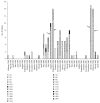Association of Antibiotic Resistance, Cell Adherence, and Biofilm Production with the Endemicity of Nosocomial Klebsiella pneumoniae
- PMID: 30345305
- PMCID: PMC6174813
- DOI: 10.1155/2018/7012958
Association of Antibiotic Resistance, Cell Adherence, and Biofilm Production with the Endemicity of Nosocomial Klebsiella pneumoniae
Abstract
Klebsiella pneumoniae is a leading cause of multiple nosocomial infections, some of which are associated with high mortality. The increasing prevalence of antibiotic-resistant strains highlights their clinical importance and how complicated managing treatment can be. In this study, we investigated antimicrobial resistance, cell adherence, and biofilm production of nosocomial K. pneumoniae strains isolated from surveillance studies in a Mexican tertiary hospital and evaluated the potential association of these phenotypes with endemicity. The great majority of the clones exhibited adhesion to cultured epithelial cells and were strong biofilm producers. A direct relationship between adhesion phenotypes, biofilm production, and endemicity was not always apparent. Biofilm formation and production of ESBL did not appear to be directly associated. Notably, all the endemic strains were multidrug-resistant. This study emphasizes that while endemic strains possess various virulence-associated properties, antimicrobial resistance appears to be a determining factor of their endemicity.
Figures



References
-
- Khan H. A., Ahmad A., Mehboob R. Nosocomial infections and their control strategies. Asian Pacific Journal of Tropical Biomedicine. 2015;5(7):509–514. doi: 10.1016/j.apjtb.2015.05.001. - DOI
-
- Alcantar-Curiel D., Tinoco J. C., Gayosso C., et al. Nosocomial bacteremia and urinary tract infections caused by extended-spectrum β-lactamase-producing Klebsiella pneumoniae with plasmids carrying both SHV-5 and TLA-1 genes. Clinical Infectious Diseases. 2004;38(8):1067–1074. doi: 10.1086/382354. - DOI - PubMed
MeSH terms
LinkOut - more resources
Full Text Sources
Other Literature Sources
Medical

